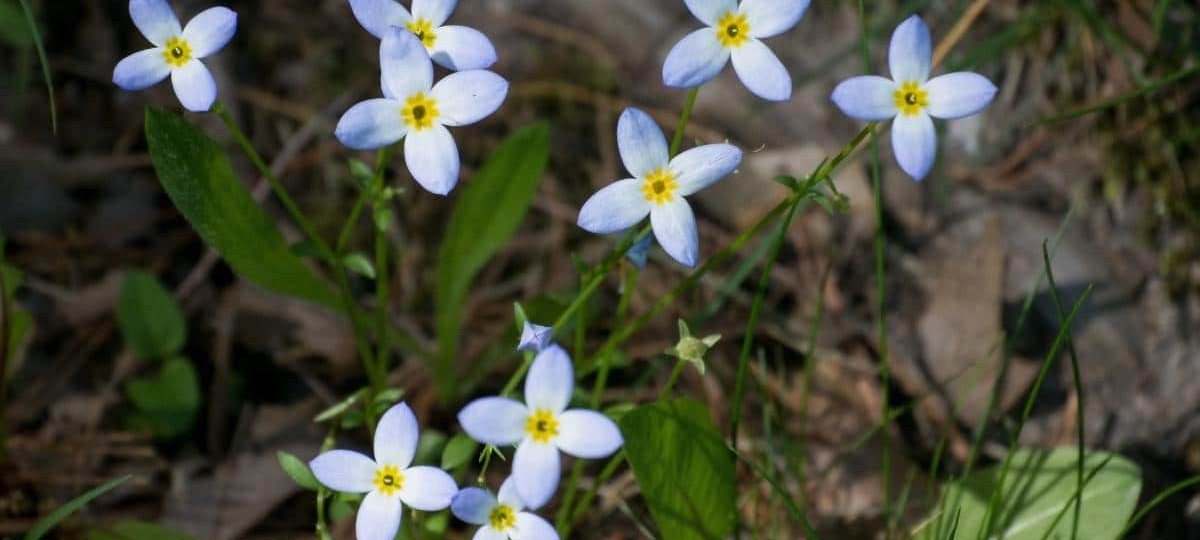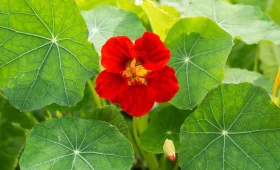memme.info – The Bluet (Houstonia caerulea) is a small, yet stunning wildflower known for its delicate blue flowers and charming appearance. Native to North America, Bluet thrives in a variety of habitats, from woodlands to meadows, and is a popular choice for wildflower gardens and natural landscapes. Despite its modest size, Bluet packs a punch with its vibrant blue hue, making it a beloved flower for those who appreciate the simple beauty of nature.
Appearance and Characteristics
Bluet is a low-growing perennial that typically reaches a height of 4 to 10 inches (10 to 25 cm). Its compact size and spreading habit make it an ideal plant for ground cover, between larger plants, or along the edges of garden beds. The plant produces small, star-like flowers that are typically light to deep blue, although white and purple variations can also occur. Each flower features four petals and a yellow center, contributing to its overall star-shaped appearance.
The flowers are borne in loose clusters at the top of the plant’s slender, upright stems, and they bloom from early spring to early summer. Bluets are known for their abundance of blooms, which create a carpet of color in the landscape. Despite their small size, the flowers attract pollinators such as bees and butterflies, contributing to the health of the garden ecosystem.
The foliage of Bluet consists of small, opposite, ovate leaves that are bright green. The leaves are often densely packed along the stems, creating a lush, low mound of greenery beneath the flowers. The plant’s growth habit is compact, and its small size allows it to blend beautifully with other wildflowers, grasses, or garden plants, making it an excellent choice for naturalistic or meadow-style plantings.
Growing Conditions and Care
Bluet is a hardy, adaptable plant that thrives in a variety of growing conditions. It is best suited to USDA hardiness zones 3 to 8, making it suitable for a wide range of climates. Bluet prefers moist, well-drained soil and typically grows in acidic to neutral soils, although it can tolerate a range of soil types. The plant thrives in full sun to partial shade, although it blooms most profusely when it receives plenty of sunlight.
While Bluet is relatively low-maintenance, it benefits from a well-drained location with consistent moisture. In particularly dry periods, regular watering is recommended to keep the soil evenly moist. The plant does not tolerate standing water, so it’s important to avoid overwatering and ensure proper drainage to prevent root rot.
Bluets are tolerant of moderate drought once established, making them a great choice for xeriscaping or low-water gardens. They are also relatively pest-resistant, with few serious issues, though aphids and other small insects can sometimes cause damage. Regular inspection and the use of organic insecticidal soap can help control any pest problems that arise.
Although Bluet doesn’t require regular fertilization, a light application of a balanced, slow-release fertilizer in early spring can encourage healthy growth and more abundant blooms. Additionally, removing spent flowers can help promote additional blooming throughout the season and keep the plant looking tidy.
Benefits and Uses
Bluet is an excellent plant for naturalistic gardens, wildflower meadows, and native plant gardens. Its bright blue flowers provide a burst of color in spring and early summer, and its low-growing habit makes it ideal for ground cover. Bluets can be used to fill in gaps between taller plants, providing a soft and delicate look to the garden while also helping to suppress weeds.
In addition to its ornamental value, Bluet is a valuable plant for supporting local wildlife. Its small flowers are a favorite of pollinators such as bees and butterflies, and the plant’s dense foliage provides shelter for small creatures. Bluet is also a great addition to butterfly gardens, as it attracts not only adult butterflies but also provides a habitat for caterpillars.
Because of its modest size, Bluet is well-suited for containers and hanging baskets, where it can spill over the edges and create a natural, cascading effect. It also works well in rock gardens, where its compact growth and ability to thrive in less-than-ideal soil conditions make it a perfect fit.
For those interested in creating a peaceful, nature-inspired landscape, Bluet is a must-have plant. Its vibrant blue flowers bring a touch of tranquility and serenity to any space, and its low-growing form creates a soft, natural carpet of color that is ideal for soothing, garden environments.
Symbolism and Cultural Significance
While Bluet does not have as much widespread symbolism as some other flowers, it is often associated with simplicity, purity, and natural beauty. The plant’s delicate, unassuming appearance makes it a symbol of grace and understated elegance. In some cultures, the blue color of the flowers may also symbolize calmness, peace, and serenity.
Bluet’s connection to nature and its role in supporting local pollinators and wildlife give it a place in the environmental movement. As gardeners increasingly focus on sustainable practices, planting wildflowers like Bluet is seen as a way to contribute to the conservation of native species and create habitats for important pollinators.
Conclusion
Bluet is a small but beautiful wildflower that brings charm, color, and ecological benefits to any garden. Its striking blue flowers, low-maintenance care, and ability to thrive in a variety of conditions make it an excellent addition to wildflower meadows, natural gardens, and pollinator-friendly landscapes. With its delicate blooms and compact size, Bluet provides a soft, natural carpet of color that enhances the beauty of any outdoor space.
Whether planted in garden beds, rock gardens, or containers, Bluet offers year-round interest, from its early spring blooms to its lush green foliage. Its role in supporting pollinators and wildlife further underscores its value in the garden. For those looking to add a simple yet stunning wildflower to their garden, Bluet is an ideal choice that will continue to bring joy and beauty for many seasons to come.




